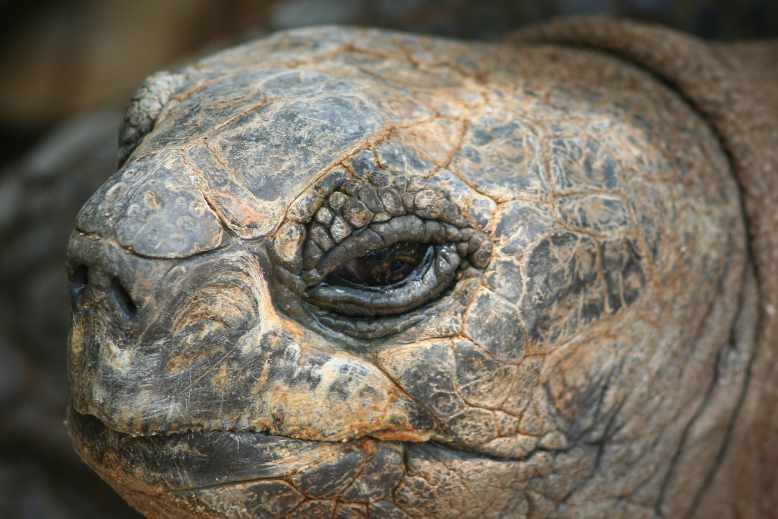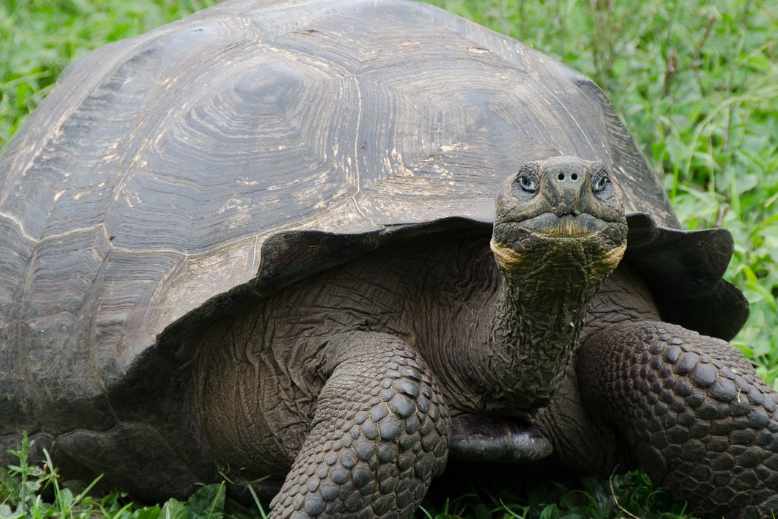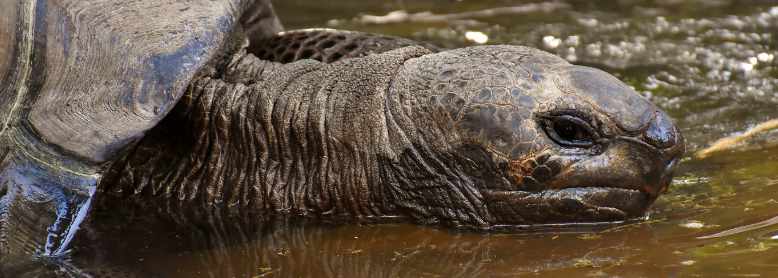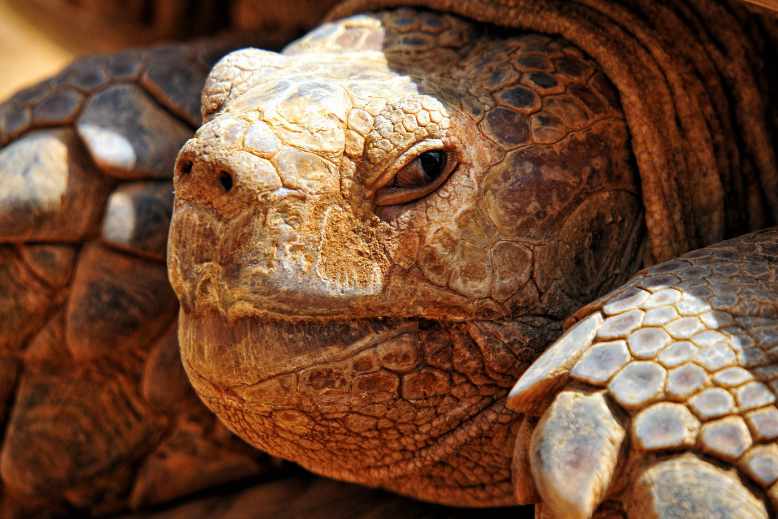Can tortoise see in the dark? Yes, tortoises can and do see in the dark. They have an acute amount of rod cells in their eye retinas, giving them a super-strong night vision. In fact, a tortoise’s eyesight is so powerful that the shelled pet can see even better than humans and some other animals.

Most reptile lovers don’t necessarily assume that their tortoises are nocturnal animals. Some of us even believe that when we turn off the lights, our tortoises also close their eyes to get their much-needed nap. But let us tell you, that’s certainly not the case! Most tortoise species try to find their way around in the darkness, and they usually do this to make up for the lack of other sensory abilities.
If you are a newbie tortoise owner who wishes to get more details on the sensory abilities of this magnificent animal, this article is just for you. We will discuss can tortoises see in the dark, and if they can, how good is their eyesight?
Let’s find out!
Can tortoises see in the dark?
Tortoises are pretty exciting and versatile animals prevalent in various environments around the globe, from tropical swamps to wildernesses. Needless to say, some tortoises are also kept in enclosures and aquariums as captive pets.
Since most tortoise species are found outside in the wild, it is natural to assume that they must have some kind of night vision to helm their ways around.
When the dusk settles over the horizon and tortoises are left to protect themselves against hungry predators, how else do they navigate their habitats? Maybe they just hide in their strong shells and wait for the sun to come out again, right?
While this seems like a pretty intelligent solution, this can’t be true because tortoises are extremely resourceful reptiles. Their smaller size and vulnerability to wild predators make them a quick snack, and that’s the reason tortoises frequently change their environments so they can survive. A tortoise is known to adapt to just about any habitat, and that must be how these reptiles have been around for about 200 million years, which is a pretty long period to adapt for survival and wouldn’t be possible without having a great night vision.

How does a tortoise’s night vision work ?
Tortoises have numerous rod cells in their eye retinas, helping them find food and navigate ways in the darkness. Their eyes can adjust to the dark, making them see at night just the way they would see during the day. This fantastic sensory ability enables tortoises to detect predators lurking in the darkness.
The countless rod cells built into the eye structure of tortoises allow them to continue to see clearly even when the night falls. These cold-blooded animals use this ability to find food and hide from predators trying to hunt them down in the last hours of the night.
Rod cells are basically photoreceptors located in the eye retina. Eye retina is the layer of eyeball made with light-sensitive cells, including rods, supporting visuals at low light levels. Light-sensitive rods convert what is available into a clear visual.
Our human eye doesn’t have as many rod cells; that’s why we cannot see around when the darkness reaches a certain level.
On the other hand, tortoises don’t stumble around in the dark and are perfectly capable of making their way around.
How strong is a tortoise’s sense of sight?
Now that you know tortoises have amazing night vision abilities and can see clearly in the dark, you might be thinking how good their sense of sight is?
Well, tortoises are able to see clearly during the day and at night. They have a great sense of sight and can recognize a full spectrum of colors, from red to ultraviolet. They can see their environment in full color and will usually be looking in front of them throughout the day, navigating through their habitat.
The clear, colorful sight and vicinity to objects they are looking at enables them to avoid predators and find food at any time of the day.
Other tortoise senses
As stated earlier, tortoise eyesight makes up for the lack of other senses. To be more specific, tortoises don’t have a great sense of hearing, and they only respond to a few particular noises, such as the noise of their own eggs hatching and the sound of mating signals from other tortoises.
To comprise for their limited hearing abilities, tortoises respond to the vibrations present in their environment. The flexibility of their neck muscles and incredible vision compensate for what they lack in other sensory areas.
Here we have mentioned a list to give you an overview of different sensory abilities a tortoise may have. Surprisingly, tortoises also have a loose sense of time and can use signals from their surroundings to make inferences.
Tortoise senses:
- Night vision
- Sense of sight
- Ability to sense vibrations
- Loose sense of time
So, exactly how powerful is a tortoise’s night vision?

Though it is for sure that tortoises have the ability to see when the sun goes down, it doesn’t mean that their night vision is just as powerful as their day vision is.
The truth is:
- Tortoises have impressive night vision, but it is not as sharp as day vision.
- Night vision isn’t used frequently.
Let us explain.
Tortoises can see a full spectrum of colors during daylight hours. Everything they look at throughout the day is right in front of them, and they don’t have to focus on the target.
On the other hand, their night vision is not as sharp as their daytime vision because they rarely use it. Most tortoise species are active during the day when the sun is out, so they don’t need night vision as much as they require day vision. In simple words, tortoises are physically capable of navigating in darkness, but they don’t pressingly have to.
Can tortoise see in the dark? Related Questions.
- Are tortoises blind?
Tortoises have a good vision, but their eyesight isn’t as good as humans. They have peripheral vision and can only identify the object in front of them. Their daytime vision helps them locate different items on the ground and move around during the day.
Tortoises rely entirely on their eyesight to forage for food and detect when predators are approaching.
However, there can be some cases of tortoise blindness. A tortoise may hatch blind or lose its vision when getting older due to different sorts of infections. When tortoises get blind, they become immobile and lose their sense of direction. They also find it hard to respond to any visual stimuli.
When a tortoise loses its vision, the chances of its survival become slim. While blindness is well managed in captive tortoises, where owners take responsibility for their pets, it becomes exceptionally challenging for wild tortoises to survive with this condition.
- What should a tortoise eye look like?

Well, the answer to this query many depends on a tortoise species. Usually, tortoises are famous for having bright black eyes, but some can have orange or brown-colored eyes.
It is good to know how your pet’s eyes should look like because if something gets wrong, you can seek professional attention at once.
Healthy tortoise eyes are usually clear and without any discharge. They can get watery at times, but not excessively.
If you feel your tortoise’s eyes are puffy or closed for more than a while, there can be a health concern requiring some medical attention. Try to open the shelled pet’s eyes to determine the root of this issue. You can use a ball of cotton wool soaked in lukewarm water to open the eyelids if they are stuck. Remember, the upper part of the eye is stuck, but the lower part is flexible.
- Can tortoises see colors?
Yes. Tortoises are perfectly capable of distinguishing between multiple colors. According to a study by Contributions to Zoology, tortoises use their color vision to:
- Identify the food items they like.
- Avoid eating toxic plants.
- Evaluate the health advantages of their diet.
- What colors can tortoises see?
Tortoises can see and recognize the whole UV spectrum, and they can see all the colors that we humans can see. According to the Journal of Applied Animal Welfare Science’s experiment, tortoises have a higher affinity to certain colors. In this experiment, different tortoises were placed in a testing area that had either:
- A block dyed in blue, red, green, or yellow color.
- A banana.
The researchers introduced tortoises with one item at a time. The amount of time the cold-blooded pet spent while interacting with an item determined its preference for that object. The study recorded the following actions
- Approaching
- Smelling
- Nudging
- Eating
The study results stated that tortoises can at least distinguish between red and yellow colors. That’s because as compared to darker colors (green and blue), they preferred the brighter ones (red, orange, and yellow).
- Do tortoises have eyelids?

Unlike most animals, these cold-blooded pets have three eyelids. They have an upper eyelid, a lower eyelid, and a thin membrane serving as a third eyelid. These eyelids help them protect their eyes when they rest or take a nap. Plus, eyelids are imperative in protecting a tortoise’s eye from dust particles and eye injuries. These organs also serve as a protective shield when an object like an air particle tries to enter the eye.
- Do tortoises have eyebrows?
The primary role of eyebrows and eyelashes is to prevent dust particles and sweat from getting into the eyes. These protective hairs are usually found in mammals because their physical structure is made up of fur. On the other hand, reptiles like turtles and tortoises don’t have hair around their eyes.
- How far can a tortoise see?
Tortoise eyesight is pretty restricted as it can only see the items closer to the ground. These reptiles focus on the objects that are right before them. Nevertheless, their peripheral vision gives them a slight advantage over other animals. Tortoise can see what’s coming towards them from either side without turning their heads. This enables them to be aware of their surroundings.
Conversely, your pet tortoise’s eyesight is not as advanced as your vision. The magnificent reptiles don’t see images clearly and are unable to see distant subjects. Their vision only lets them know what’s closer to them and near the ground.

- How well can a tortoise see?
Tortoises have an excellent vision range. They can see what’s around and in front of them. They are quick at noticing if something moves. However, a tortoise may not see objects as clearly as humans do. The fellow may not be able to tell the difference between multiple objects using fine details such as cuts and lines.
Surprisingly, to some extent, the tortoises can see the UV range like humans. They have evolved into seeing in complete darkness or in low light. Tortoise as can also recognize some brightly colored objects. All these characteristics show that tortoises have good eyesight compared to other animals.
- Are tortoise eye infections really a thing?
Poor nutrition and unsanitary housing conditions can make a tortoise susceptible to multiple eye-related infections. And if not provided with medical attention, these infections can get severe and put your beloved pet’s life or eyesight in danger.
Tortoise eye infection may seem like a pretty harmless white discharge or sport in the eye cornea. But if untreated, these “harmless” discharges can lead to eye ulcers. The adorable pet can also suffer from contracts, an eye condition causing swelling and irritation.
As soon as you notice any vision-related abnormalities, consult an expert about it.
Final Words
So, can tortoises see in the dark? Yes, tortoises can see in the dark thanks to their special night vision abilities. This ability comes from the impressive number of rod cells located in the retinas of their eyes.
Though they can see in the dark, their night vision is not that strong.




